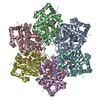+ Open data
Open data
- Basic information
Basic information
| Entry |  | |||||||||
|---|---|---|---|---|---|---|---|---|---|---|
| Title | SV40 large T antigen assembly with DNA in presence of ADP | |||||||||
 Map data Map data | Post-processed map (EMReady). | |||||||||
 Sample Sample |
| |||||||||
 Keywords Keywords | AAA+ superfamily Helicase Substrate translocation DNA unwinding / DNA BINDING PROTEIN | |||||||||
| Function / homology |  Function and homology information Function and homology informationsymbiont-mediated suppression of host JAK-STAT cascade via inhibition of JAK1 activity / bidirectional double-stranded viral DNA replication / viral DNA genome replication / DNA 3'-5' helicase / symbiont-mediated perturbation of host cell cycle G1/S transition checkpoint / DNA replication origin binding / helicase activity / single-stranded DNA binding / double-stranded DNA binding / symbiont-mediated perturbation of host ubiquitin-like protein modification ...symbiont-mediated suppression of host JAK-STAT cascade via inhibition of JAK1 activity / bidirectional double-stranded viral DNA replication / viral DNA genome replication / DNA 3'-5' helicase / symbiont-mediated perturbation of host cell cycle G1/S transition checkpoint / DNA replication origin binding / helicase activity / single-stranded DNA binding / double-stranded DNA binding / symbiont-mediated perturbation of host ubiquitin-like protein modification / DNA replication / symbiont-mediated suppression of host innate immune response / symbiont-mediated suppression of host type I interferon-mediated signaling pathway / host cell nucleus / ATP hydrolysis activity / zinc ion binding / ATP binding / identical protein binding Similarity search - Function | |||||||||
| Biological species |  Betapolyomavirus macacae / synthetic construct (others) Betapolyomavirus macacae / synthetic construct (others) | |||||||||
| Method | single particle reconstruction / cryo EM / Resolution: 3.38 Å | |||||||||
 Authors Authors | Shahid T | |||||||||
| Funding support |  United Kingdom, United Kingdom,  Saudi Arabia, 2 items Saudi Arabia, 2 items
| |||||||||
 Citation Citation |  Journal: Nature / Year: 2025 Journal: Nature / Year: 2025Title: Structural dynamics of DNA unwinding by a replicative helicase. Authors: Taha Shahid / Ammar U Danazumi / Muhammad Tehseen / Lubna Alhudhali / Alice R Clark / Christos G Savva / Samir M Hamdan / Alfredo De Biasio /   Abstract: Hexameric helicases are nucleotide-driven molecular machines that unwind DNA to initiate replication across all domains of life. Despite decades of intensive study, several critical aspects of their ...Hexameric helicases are nucleotide-driven molecular machines that unwind DNA to initiate replication across all domains of life. Despite decades of intensive study, several critical aspects of their function remain unresolved: the site and mechanism of DNA strand separation, the mechanics of unwinding propagation, and the dynamic relationship between nucleotide hydrolysis and DNA movement. Here, using cryo-electron microscopy (cryo-EM), we show that the simian virus 40 large tumour antigen (LTag) helicase assembles in the form of head-to-head hexamers at replication origins, melting DNA at two symmetrically positioned sites to establish bidirectional replication forks. Through continuous heterogeneity analysis, we characterize the conformational landscape of LTag on forked DNA under catalytic conditions, demonstrating coordinated motions that drive DNA translocation and unwinding. We show that the helicase pulls the tracking strand through DNA-binding loops lining the central channel, while directing the non-tracking strand out of the rear, in a cyclic process. ATP hydrolysis functions as an 'entropy switch', removing blocks to translocation rather than directly powering DNA movement. Our structures show the allosteric couplings between nucleotide turnover and subunit motions that enable DNA unwinding while maintaining dedicated exit paths for the separated strands. These findings provide a comprehensive model for replication fork establishment and progression that extends from viral to eukaryotic systems. More broadly, they introduce fundamental principles of the mechanism by which ATP-dependent enzymes achieve efficient mechanical work through entropy-driven allostery. | |||||||||
| History |
|
- Structure visualization
Structure visualization
| Supplemental images |
|---|
- Downloads & links
Downloads & links
-EMDB archive
| Map data |  emd_50002.map.gz emd_50002.map.gz | 105.4 MB |  EMDB map data format EMDB map data format | |
|---|---|---|---|---|
| Header (meta data) |  emd-50002-v30.xml emd-50002-v30.xml emd-50002.xml emd-50002.xml | 22.9 KB 22.9 KB | Display Display |  EMDB header EMDB header |
| FSC (resolution estimation) |  emd_50002_fsc.xml emd_50002_fsc.xml | 12.7 KB | Display |  FSC data file FSC data file |
| Images |  emd_50002.png emd_50002.png | 117.4 KB | ||
| Masks |  emd_50002_msk_1.map emd_50002_msk_1.map | 216 MB |  Mask map Mask map | |
| Filedesc metadata |  emd-50002.cif.gz emd-50002.cif.gz | 7.1 KB | ||
| Others |  emd_50002_half_map_1.map.gz emd_50002_half_map_1.map.gz emd_50002_half_map_2.map.gz emd_50002_half_map_2.map.gz | 200.6 MB 200.6 MB | ||
| Archive directory |  http://ftp.pdbj.org/pub/emdb/structures/EMD-50002 http://ftp.pdbj.org/pub/emdb/structures/EMD-50002 ftp://ftp.pdbj.org/pub/emdb/structures/EMD-50002 ftp://ftp.pdbj.org/pub/emdb/structures/EMD-50002 | HTTPS FTP |
-Validation report
| Summary document |  emd_50002_validation.pdf.gz emd_50002_validation.pdf.gz | 960.2 KB | Display |  EMDB validaton report EMDB validaton report |
|---|---|---|---|---|
| Full document |  emd_50002_full_validation.pdf.gz emd_50002_full_validation.pdf.gz | 959.7 KB | Display | |
| Data in XML |  emd_50002_validation.xml.gz emd_50002_validation.xml.gz | 21 KB | Display | |
| Data in CIF |  emd_50002_validation.cif.gz emd_50002_validation.cif.gz | 27 KB | Display | |
| Arichive directory |  https://ftp.pdbj.org/pub/emdb/validation_reports/EMD-50002 https://ftp.pdbj.org/pub/emdb/validation_reports/EMD-50002 ftp://ftp.pdbj.org/pub/emdb/validation_reports/EMD-50002 ftp://ftp.pdbj.org/pub/emdb/validation_reports/EMD-50002 | HTTPS FTP |
-Related structure data
| Related structure data | 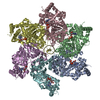 9evhMC  9evpC 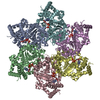 9exdC 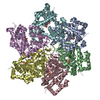 9f3tC 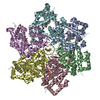 9f3uC 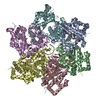 9f5iC 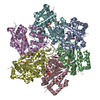 9f73C 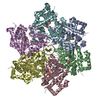 9f74C  9f75C 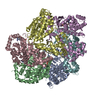 9f7nC 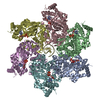 9f9nC 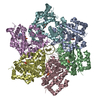 9f9oC 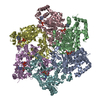 9f9wC  9f9xC  9fa1C  9fa2C  9fb0C  9fb4C  9fb5C  9fb6C 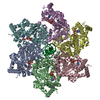 9kaeC  9kakC M: atomic model generated by this map C: citing same article ( |
|---|---|
| Similar structure data | Similarity search - Function & homology  F&H Search F&H Search |
- Links
Links
| EMDB pages |  EMDB (EBI/PDBe) / EMDB (EBI/PDBe) /  EMDataResource EMDataResource |
|---|---|
| Related items in Molecule of the Month |
- Map
Map
| File |  Download / File: emd_50002.map.gz / Format: CCP4 / Size: 125 MB / Type: IMAGE STORED AS FLOATING POINT NUMBER (4 BYTES) Download / File: emd_50002.map.gz / Format: CCP4 / Size: 125 MB / Type: IMAGE STORED AS FLOATING POINT NUMBER (4 BYTES) | ||||||||||||||||||||||||||||||||||||
|---|---|---|---|---|---|---|---|---|---|---|---|---|---|---|---|---|---|---|---|---|---|---|---|---|---|---|---|---|---|---|---|---|---|---|---|---|---|
| Annotation | Post-processed map (EMReady). | ||||||||||||||||||||||||||||||||||||
| Projections & slices | Image control
Images are generated by Spider. | ||||||||||||||||||||||||||||||||||||
| Voxel size | X=Y=Z: 1 Å | ||||||||||||||||||||||||||||||||||||
| Density |
| ||||||||||||||||||||||||||||||||||||
| Symmetry | Space group: 1 | ||||||||||||||||||||||||||||||||||||
| Details | EMDB XML:
|
-Supplemental data
-Mask #1
| File |  emd_50002_msk_1.map emd_50002_msk_1.map | ||||||||||||
|---|---|---|---|---|---|---|---|---|---|---|---|---|---|
| Projections & Slices |
| ||||||||||||
| Density Histograms |
-Half map: #1
| File | emd_50002_half_map_1.map | ||||||||||||
|---|---|---|---|---|---|---|---|---|---|---|---|---|---|
| Projections & Slices |
| ||||||||||||
| Density Histograms |
-Half map: #2
| File | emd_50002_half_map_2.map | ||||||||||||
|---|---|---|---|---|---|---|---|---|---|---|---|---|---|
| Projections & Slices |
| ||||||||||||
| Density Histograms |
- Sample components
Sample components
-Entire : Large T antigen with DNA in presence of ADP.
| Entire | Name: Large T antigen with DNA in presence of ADP. |
|---|---|
| Components |
|
-Supramolecule #1: Large T antigen with DNA in presence of ADP.
| Supramolecule | Name: Large T antigen with DNA in presence of ADP. / type: complex / ID: 1 / Parent: 0 / Macromolecule list: #1-#2 |
|---|
-Supramolecule #2: Large T antigen
| Supramolecule | Name: Large T antigen / type: complex / ID: 2 / Parent: 1 / Macromolecule list: #1 |
|---|---|
| Source (natural) | Organism:  Betapolyomavirus macacae Betapolyomavirus macacae |
-Supramolecule #3: DNA
| Supramolecule | Name: DNA / type: complex / ID: 3 / Parent: 1 / Macromolecule list: #2 |
|---|---|
| Source (natural) | Organism: synthetic construct (others) |
-Macromolecule #1: Large T antigen
| Macromolecule | Name: Large T antigen / type: protein_or_peptide / ID: 1 / Number of copies: 6 / Enantiomer: LEVO EC number: Hydrolases; Acting on acid anhydrides; Acting on acid anhydrides to facilitate cellular and subcellular movement |
|---|---|
| Source (natural) | Organism:  Betapolyomavirus macacae Betapolyomavirus macacae |
| Molecular weight | Theoretical: 81.732953 KDa |
| Recombinant expression | Organism:  |
| Sequence | String: MDKVLNREES LQLMDLLGLE RSAWGNIPLM RKAYLKKCKE FHPDKGGDEE KMKKMNTLYK KMEDGVKYAH QPDFGGFWDA TEIPTYGTD EWEQWWNAFN EENLFCSEEM PSSDDEATAD SQHSTPPKKK RKVEDPKDFP SELLSFLSHA VFSNRTLACF A IYTTKEKA ...String: MDKVLNREES LQLMDLLGLE RSAWGNIPLM RKAYLKKCKE FHPDKGGDEE KMKKMNTLYK KMEDGVKYAH QPDFGGFWDA TEIPTYGTD EWEQWWNAFN EENLFCSEEM PSSDDEATAD SQHSTPPKKK RKVEDPKDFP SELLSFLSHA VFSNRTLACF A IYTTKEKA ALLYKKIMEK YSVTFISRHN SYNHNILFFL TPHRHRVSAI NNYAQKLCTF SFLICKGVNK EYLMYSALTR DP FSVIEES LPGGLKEHDF NPEEAEETKQ VSWKLVTEYA METKCDDVLL LLGMYLEFQY SFEMCLKCIK KEQPSHYKYH EKH YANAAI FADSKNQKTI CQQAVDTVLA KKRVDSLQLT REQMLTNRFN DLLDRMDIMF GSTGSADIEE WMAGVAWLHC LLPK MDSVV YDFLKCMVYN IPKKRYWLFK GPIDSGKTTL AAALLELCGG KALNVNLPLD RLNFELGVAI DQFLVVFEDV KGTGG ESRD LPSGQGINNL DNLRDYLDGS VKVNLEKKHL NKRTQIFPPG IVTMNEYSVP KTLQARFVKQ IDFRPKDYLK HCLERS EFL LEKRIIQSGI ALLLMLIWYR PVAEFAQSIQ SRIVEWKERL DKEFSLSVYQ KMKFNVAMGI GVLDWLRNSD DDDEDSQ EN ADKNEDGGEK NMEDSGHETG IDSQSQGSFQ APQSSQSVHD HNQPYHICRG FTCFKKPPTP PPEPET UniProtKB: Large T antigen |
-Macromolecule #2: DNA
| Macromolecule | Name: DNA / type: dna / ID: 2 / Number of copies: 1 / Classification: DNA |
|---|---|
| Source (natural) | Organism: synthetic construct (others) |
| Molecular weight | Theoretical: 2.084392 KDa |
| Sequence | String: (DT)(DT)(DT)(DT)(DT)(DT)(DT) |
-Macromolecule #3: ADENOSINE-5'-DIPHOSPHATE
| Macromolecule | Name: ADENOSINE-5'-DIPHOSPHATE / type: ligand / ID: 3 / Number of copies: 6 / Formula: ADP |
|---|---|
| Molecular weight | Theoretical: 427.201 Da |
| Chemical component information |  ChemComp-ADP: |
-Experimental details
-Structure determination
| Method | cryo EM |
|---|---|
 Processing Processing | single particle reconstruction |
| Aggregation state | particle |
- Sample preparation
Sample preparation
| Concentration | 0.1 mg/mL |
|---|---|
| Buffer | pH: 8 / Details: 200 mM NaCl, 50 mM Tris-HCl (pH 8.0), 1 mM ADP. |
| Grid | Model: UltrAuFoil / Material: GOLD / Support film - Material: GRAPHENE OXIDE / Pretreatment - Type: GLOW DISCHARGE |
| Vitrification | Cryogen name: ETHANE / Chamber humidity: 100 % / Chamber temperature: 277 K / Instrument: FEI VITROBOT MARK IV |
- Electron microscopy
Electron microscopy
| Microscope | FEI TITAN KRIOS |
|---|---|
| Specialist optics | Energy filter - Name: GIF Bioquantum / Energy filter - Slit width: 20 eV |
| Image recording | Film or detector model: GATAN K3 BIOQUANTUM (6k x 4k) / Number real images: 9737 / Average exposure time: 2.0 sec. / Average electron dose: 50.0 e/Å2 |
| Electron beam | Acceleration voltage: 300 kV / Electron source:  FIELD EMISSION GUN FIELD EMISSION GUN |
| Electron optics | C2 aperture diameter: 50.0 µm / Illumination mode: FLOOD BEAM / Imaging mode: BRIGHT FIELD / Cs: 2.7 mm / Nominal defocus max: 2.5 µm / Nominal defocus min: 1.0 µm / Nominal magnification: 105000 |
| Sample stage | Specimen holder model: FEI TITAN KRIOS AUTOGRID HOLDER / Cooling holder cryogen: NITROGEN |
| Experimental equipment |  Model: Titan Krios / Image courtesy: FEI Company |
 Movie
Movie Controller
Controller











































 Z (Sec.)
Z (Sec.) Y (Row.)
Y (Row.) X (Col.)
X (Col.)













































